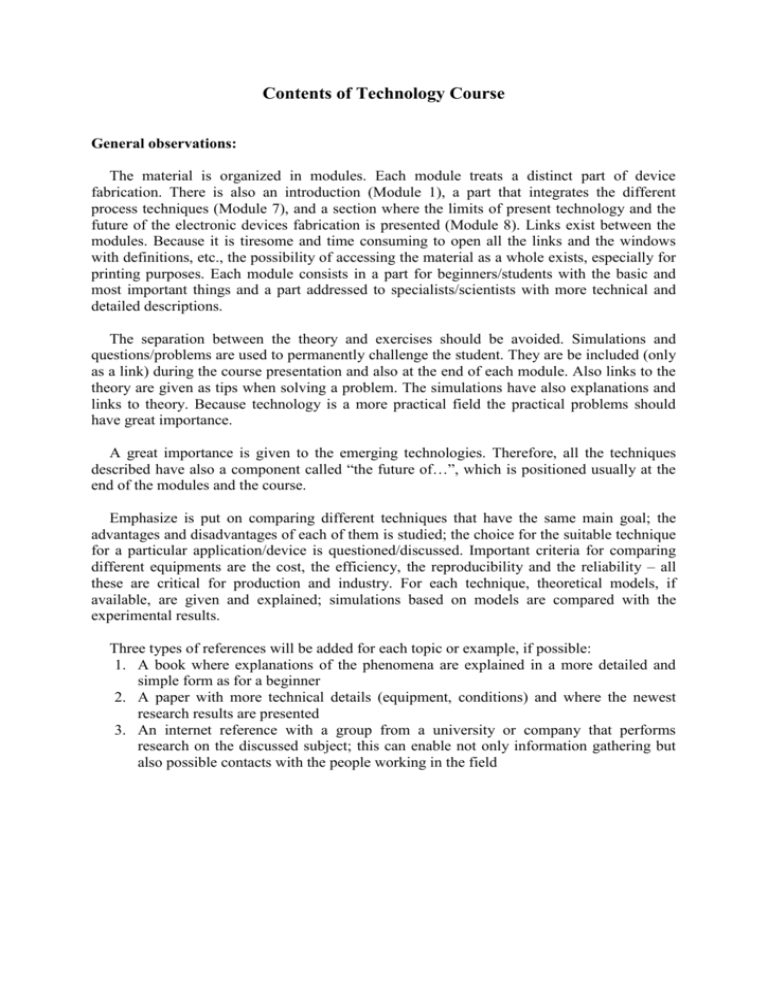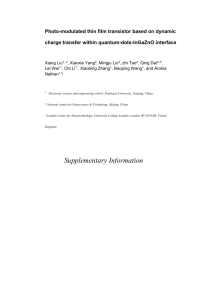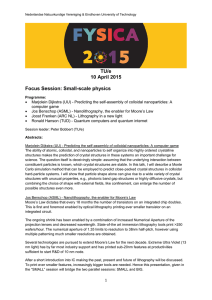Contents of Technology Course
advertisement

Contents of Technology Course General observations: The material is organized in modules. Each module treats a distinct part of device fabrication. There is also an introduction (Module 1), a part that integrates the different process techniques (Module 7), and a section where the limits of present technology and the future of the electronic devices fabrication is presented (Module 8). Links exist between the modules. Because it is tiresome and time consuming to open all the links and the windows with definitions, etc., the possibility of accessing the material as a whole exists, especially for printing purposes. Each module consists in a part for beginners/students with the basic and most important things and a part addressed to specialists/scientists with more technical and detailed descriptions. The separation between the theory and exercises should be avoided. Simulations and questions/problems are used to permanently challenge the student. They are be included (only as a link) during the course presentation and also at the end of each module. Also links to the theory are given as tips when solving a problem. The simulations have also explanations and links to theory. Because technology is a more practical field the practical problems should have great importance. A great importance is given to the emerging technologies. Therefore, all the techniques described have also a component called “the future of…”, which is positioned usually at the end of the modules and the course. Emphasize is put on comparing different techniques that have the same main goal; the advantages and disadvantages of each of them is studied; the choice for the suitable technique for a particular application/device is questioned/discussed. Important criteria for comparing different equipments are the cost, the efficiency, the reproducibility and the reliability – all these are critical for production and industry. For each technique, theoretical models, if available, are given and explained; simulations based on models are compared with the experimental results. Three types of references will be added for each topic or example, if possible: 1. A book where explanations of the phenomena are explained in a more detailed and simple form as for a beginner 2. A paper with more technical details (equipment, conditions) and where the newest research results are presented 3. An internet reference with a group from a university or company that performs research on the discussed subject; this can enable not only information gathering but also possible contacts with the people working in the field Contents: Module 1. Introduction Course organization in modules and course objectives Overview of microelectronic devices a history of developments in electronic devices fabrication process overview (presentation of the basic process steps, clean room protocols) device overview (presentation of material structure and properties, devices, charge motion) Motivation – the importance of electronics (pictured examples of microelectronic devices such as MOSFET, IC, MEMS, sensors and actuators, LED, photonic crystals, MRAM) and the future of electronic device fabrication (rapidly emerging technologies, nanotechnology) Module 2. Semiconductor growth Theory of crystal structure Crystal preparation preparation methods: Czochralski and floating zones techniques methods of preparing the crystal surface, avoiding defects, obtaining a specific purity by cleaning and gettering and the role of dopants Module 3. Changing the doping and conductivity of materials Theory – conduction mechanisms in semiconductors; the relation between the conductivity of semiconductor layers and the doping; the concept of sheet resistance Diffusion – definition of diffusion and diffusion constant, Fick’s laws, diffusion models, enhanced diffusion; equipment for diffusion and measurement methods Ion implantation – definition of ion implantation, induced damage, channeling; learning to model the process and to design “arbitrary” doping profiles; description of equipment and measurement methods; annealing the defects (rapid thermal annealing); advantages of ion implantation over diffusion Module 4. Growing and depositing thin films Film parameters – that need to be monitored for each process: uniformity, purity, step coverage, adhesion, deposition rate, defects, porosity, mechanical stress, chemical bonds, electrical properties Oxidation and nitridation – chemical reactions and growth kinetics (Deal grove model); LOCOS, description of equipment and detrimental role of impurities PVD Evaporation – description of process and different types of evaporation (resistive heating, flash evaporation, arc evaporation, exploding-wire technique, laser evaporation, rf heating, electron-bombardment heating) Sputtering – description of process and different types of sputtering (DC sputtering, RF sputtering, DC/RF magnetron sputtering, collimated and ionized sputtering, hot sputtering, reactive sputtering) metallization issues - resistivity, electromigration, planarity CVD – deposition kinetics and chemistry, vacuum systems and different regimes of gas-flow different CVD methods (APCVD, LPCVD, atomic layer deposition) PECVD – different types of plasma, study of plasma parameters influence upon film parameters (selectivity, conformality, uniformity, damage) Langmuir-Blodgett technique Epitaxy of thin films – definition of epitaxial growth of crystalline solids, the different growth stages, film nucleation, models for epitaxy applications: Si for advanced electronic devices, GaAs for optoelectronic devices, quantum well engineering types of epitaxy: Liquid Phase Epitaxy (LPE), Metal-Organic Chemical Vapor Deposition (MOCVD), Molecular Beam Epitaxy (MBE) Future – ultra thin dielectrics, high k and low k dielectric, Al replaced by Cu, W-plug Module 5. Defining patterns Lithography – patterning of the substrate via interaction of beams of photons or particles with materials classification of resist materials upon their solubility after exposure mask fabrication optical sources and types of photolithography, dependence of resolution upon exposure wavelength, dose energy and resist contrast advanced lithography for sub-100 nm region (X-ray lithography, electron beam lithography, ion beam lithography), the resolution limit for each technique and its application to particular device fabrication; the advantages and disadvantages of each technique future: nanolithography micro-contact printing, nanoimprint lithography, scanned probe lithography (carbon nanotubes as tips), dip-pen lithography (AFM tip) Etching – the physical mechanisms, the etch figures-of-merit (etch rate, uniformity, selectivity, anisotropy and undercut), different etching techniques: wet etching plasma assisted etching – various etch mechanisms in plasma (chemical, physical, ion enhanced) and how to make one dominant; different plasma etch systems (plasma, reactive ion etch, reactive ion beam etch & beam milling) and the advantages and applications of each of them lift-off chemical mechanical polishing Module 6. Materials and process characterization Thickness - ellipsometry Structure - orientation, defects and morphology of materials; characterization by electron diffraction, X-ray diffraction, TEM, REM, X-ray fluorescence Composition – characterization by interactions with different particles/waves: electrons, ions, photons, X-ray; main characterization methods: Auger, XPS, SIMS, ERD, RBS Surface – Atomic Force Microscopy (AFM), comparison of different types of AFM: constant force versus constant height, constant mode versus tapping mode In-situ measurements – Reflective High Energy Electron Diffraction (RHEED) Electrical measurements – for various test structures Future (nanocharacterization) – scanning probe microscopy AFM – by repulsion between outer electrons of tip and sample it can perceive molecules and atoms and measure atomic forces; also magnetic and capacitive force microscopy Scanning Tunnelling Microscopy (STM) – based on electron tunnelling current between tip and sample due to quantum mechanical tunnelling, the current is dependent on the distance; also possible atomic manipulation Ballistic Electron Emission Microscopy (BEEM) Near-Field Scanning Optical Microscopy (NSOM)) Module 7. Integration of individual process steps to build semiconductor devices and micro(nano)structures MOSFET / IC Magnetic transistor / MRAM Optoelectronic device (LED, photodetector) Sensor / MEMS Integrated system with everything on chip (optomechanical, sensor, CMOS and magnetical) Simulation and practical work: Design, develop, fabricate and characterize a process flow for a microstructure including materials and process characterization test structures Module 8. THE FUTURE (nanotechnology) Limits of CMOS - scaling issues and obstacles to further scaling theoretical limits (thermal limit, quantum limit) technological limits (dielectric scaling, high leakage current, breakdown voltage in junctions, increased interconnections delays, lithography, power dissipation) economical limits Bio-electric computers Quantum computers Molecular electronics ‘Smart’ lab-on-a-chip Plastic/Printed IC’s ‘Self-assembly’ Vertical/3D CMOS Micro-wireless nets Integrated Optics Metal gates Hi-k/metal oxides Low-k w/Cu SOI +2 106-107-x lower power for ‘lifetime’ micro-batteries Wearable communicators, Wireless remote medicine, ‘Hardware over the Internet’ Pervasive voice recognition, ‘Smart’ transportation, etc. Full motion mobile video, Fully integrated mobile office Now True neural computing for ‘Intelligent’ communicators, controllers, assistants +4 +6 (source: R. Cavin, SRC; Digital DNA Motorola) +8 + 10 + 12 + 14 + 16 years Quantum and single-electron devices – quantum effects in nanoelectronics, quantum dot resonant tunnelling transistor applications: quantum dot SETs fabrication, nanocrystal SETs, SET memory devices Molecular electronics – electronic devices from individual molecules; advantages and disadvantages molecules designed with specific atoms, geometries, properties applications: molecular switch, molecular diode, self-assembled molecular electronics starting from SAMs challenges: transistor fabrication, integration on a chip, heat limit Bottom-up approach self-assembly – definition; examples: thiols (RSH) on Au surface, Si terminated chains on glass, multilayered self-assembly; applications: SAMbased lithography and anti-stiction coatings in MEMS ionic self-assembly (charged particles) – controlled successive stacking on patterned surfaces, applications in nonlinear optics, LED, photovoltaics polymers for solar cells DNA self assembly – material properties, role: DNA used as glue to assemble arrays of molecules and nanoparticles, practical examples, synthesis and preparation of complementary DNA; selective attachment of DNA strands to substrate and devices Fullerene and nanotubes – definition , structure, helicity, topology, types: single-wall and multi-wall synthesis: electric arc discharge, laser evaporation, catalytic CVD orientation, cutting with STM, electronic properties (semiconductor, metal), mechanical properties potential applications and advantages: quantum wire interconnects, diodes and transistors, data storage, field emitters flat panel displays, THz oscillators, nanoprobes for AFM, sensors, nanogears technological challenges: large scale integration, reliability and control, controlled doping, process integration Spintronics Nanotechnology in magnetic systems – principle of magnetic recording, limitations, nanostructured magnetic media: self-assembled colloid magnetic particles, quantum storage, magnetoresistive heads, giant magnetoresistance Nanotechnology in integrative systems (NEMS): from MEMS to NEMS, nanomachining of single crystal layers, nuclear magnetic resonance on nanoparticles, nanoelectrometer, nanoscopic transduction, molecular NEMS Nanotechnology in optoelectronics – quantum effects in optoelectronics, epitaxial quantum dots, self-organized dots, colloid nanocrystal synthesis, quantum dot lasers, photonic bandgap materials, self-assembled photonic structures Bionanotechnology –detection and manipulation of molecules, nanofluidics, lab on a chip, monolithic nanomachining, nano-syringe biomimetism –learning by imitating nature, biomimetic films, biosensors retinal circuitry morphed into silicon, astroglial cell growth on Si structures, cell growth on patterned surfaces biohybrid devices have also a human inspired component (device), molecular motors, nanopropeller September 2003






